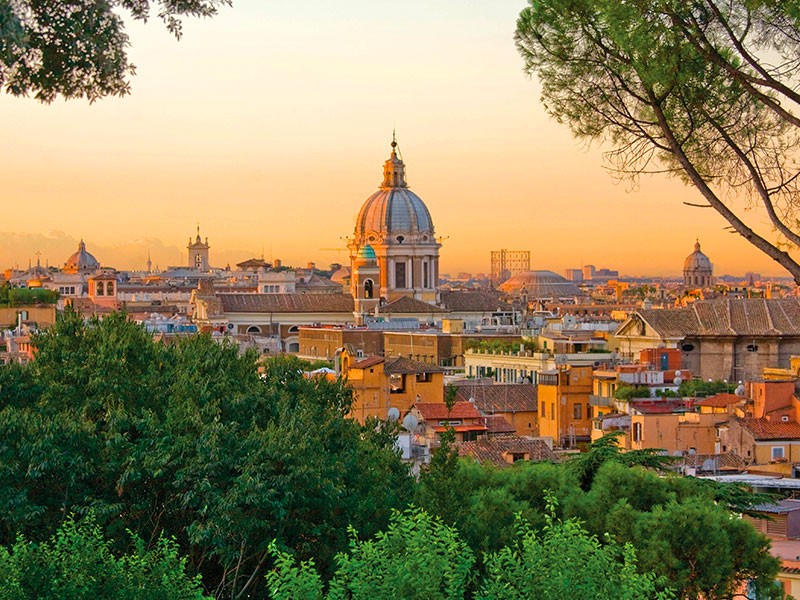We invite you to discover with us Rome and its treasures. Our itinerary includes Trastevere's district (Ponte Sisto, San Crisogono and Santa Maria in Trastevere) and the Gianicolo (the "Fontanone", San Pietro in Montorio and the "tempietto del Bramante").
Info & Booking
- Throughout the tour, you will be guided by an expert in History or Art history, Archeology or Architecture, who will help you to discover our Rome.
- You can choose the language you prefer...we have 5 different languages available!
- Tour departs from Ponte Sisto.
- It is a 2 hours long tour with a private guide.
- Tour is available from Tuesday to Sunday from 09:00 to 17:00, each hour
- Tour must be reserved with 2 weeks in advance
Itinerary
Discover some of Rome's most charming places – Trastevere and the Janiculum Hill. Follow your guide through the Trastevere district (Ponte Sisto, San Crisogono, and Santa Maria in Trastevere) and the Gianicolo (the "Fontanone", San Pietro in Montorio, and the "tempietto del Bramante"). You'll get a look behind the scenes of these popular neighborhoods.
The Ponte Sisto is the only bridge that was built over the Tiber between the fall of the Roman Empire and the 19th century. When Sixtus IV was a cardinal, he expressed the desire to have a new river crossing built, because the only way for him to reach Saint Peter's from where he was living was to use the bridge at the Castel Sant'Angelo, a long and difficult road in those days. When Sixtus IV was elected Pope, he commissioned the architect, Baccio Pontelli, to build the new bridge, authorizing him to remove the material needed from the Colosseum. Pontelli took what remained of the bridge that Agrippa had built from Campus Martius to Trastevere in the 1st century BC and incorporated it into his new bridge. The Ponte Sisto was inaugurated in the Holy Year of 1475.
During the 19th century, a heavy cast-iron superstructure was added; however, it has recently been removed, leaving the bridge in all its magnificent 15th century elegance. Just like the ancient Roman engineers, Pontelli included a circular eye in the central pier to help floodwaters flow through the bridge.
The church of San Crisogono is one of the most distinguished and ancient Roman basilicas, with the original church, dating back to 499, still visible in the basement, brought to light during excavations in 1924. This church in turn was built on one of the oldest private houses where the first Christians secretly met for worship. The church underwent several renovations and restorations. The first was in 1126, a period of intense building activity in Rome. The beautiful Romanesque Bell Tower dates back to those days. The portico and the façade were added in 1626, when the church was radically restored by Giovanni Battista Soria for Cardinal Scipione Borghese. An inscription on the lintel recalls the Cardinal, while a series of vases, eagles and dragons on the rooftop are a reference to the Borghese arms. It was on this occasion that a heavy roof section was added to the Bell Tower at the behest of Cardinal Borghese. This measure created such great risk of collapse that some of the triple windows in the original tower had to be walled up to increase structural stability. The last restoration dates back to 1866.
San Crisogono was decorated by Pietro Cavallini, while the apse mosaic was created by his school. The Basilica-shaped interior is divided into three naves supported by 22 granite columns. Two other porphyry columns, considered the largest in Rome, hold the central arch and four Alabaster columns support the Baroque style canopy. Guercino’s Glory of Saint Crisogonus adorns the center of the ceiling. Unfortunately, this painting is only a copy - the original was stolen and sold to England in 1808, where it can still be found at Stafford House in London. The statue of the Virgin of Carmel, popularly known as the "Madonna de noantri" was kept here until the early 18th century, when it was moved to the adjoining church of Saint Agatha.
Trastevere's stunning medieval basilica Santa Maria in Trastevere rises from a church converted from a private residence where Christian cults were observed. You can still visit the original church on the level below. The first group of buildings was erected in the 5th century; the present church dates back to the start of the 12th century and its appearance and proportions remain intact. The floors are decorated with mosaics from ancient buildings and the apse mosaic (13th century) has been attributed to Pietro Cavallini and depicts the Virgin with Child with San Crisogono and San Giacomo. This is definitely not the mosaic originally planned for the apse because its background is not concave but flat. The vestry leads down to the rest of the 7th century basilica and roman buildings whose frescoes have all but disappeared.
Santa Maria in Trastevere is the oldest church in Rome dedicated to the Virgin. On this spot in 38 BC a fountain of oil flowed for a whole day. Christians later interpreted this miracle as a sign of the birth of Christ. The basilica was one of the first places where the Christians could freely celebrate their religious services. Pope Calixtus built the first sanctuary between 221 and 227, it was later completed by Julius I. Under the trasteverine Pope Innocent II it was completely restored and finally embellished during the Baroque time. Nowadays it is one of the most beautiful churches of Rome. The façade is decorated with a splendid medieval mosaic showing the Virgin and Child and a procession of ten virgins approaching from both sides. The belfry dates back to the 12th century, it is among the highest and most characteristic of Rome. The interior dates back to the 12th century also. The columns were taken from ancient monuments, all are crowned with classical capitals, with the figures of some Egyptian divinities having been removed. The floor is partly in Cosmatesque style. The ceiling was decorated by Domenichino.
The true treasure of the church are the mosaics depicting the Glory of the Virgin in the apse date back to the 12th century.The mosaics and frescoes between the apse and the windows are a masterpiece by Pietro Cavallini (late 13th century) representing episodes from the life of the Virgin. Worth seeing are the small chapel of the Tabernacle, a Rococo creation by Raguzzini, and the Avila Chapel considered the foremost Baroque creation after the times of Bernini and Borromini. The Sacristy contains two fine mosaics from the 1st century AD.
The water for the Fontana dell'Acqua Paola also known as Il Fontanone ("The big fountain") comes from Trajan's ancient aqueduct. The monumental fountain called Acqua Paola after Pope Paul V who restored it after more than 1,000 years of not being used. The fountain was made at the beginning of the 17th century and part of the decoration is formed by columns coming from the old basilica of Saint Peter's.
San Pietro in Montorio was built on one of the peaks of the Janiculum Hill, also known as the Mountain of Gold for the color of the earth found there. According to a legend, this was the site of Peter's crucifixion. In 1480, Ferdinand and Isabella, the King and Queen of Spain who owned the land here, commissioned the building of a church, using the remains of a monastery dating back to the 9th century as the foundation.
Bramante's famous Tempietto (little temple) is placed inside the convent of san Pietro in Montorio. Ferdinand and Isabella, the King and Queen of Spain commissioned it in fulfillment of a vow taken at the birth of their first child. The great architect adopted a central plan for this building, making clear references to Christian martyrdom and pagan temples dedicated to heroic mythological figures. Doric columns were used to conjure up images of ancient Rome and the figure of the hero. These columns were trademarks of Vitruvius, a renowned Roman architect. In the original design, the little temple with its curved lines was supposed to be completed with a round cloister; however, the cloister was never built. Today, the Franciscan monastery has surrounded the little temple, thus creating a square courtyard instead. The Tempietto is one of the few buildings designed by Bramante that is still intact. It demonstrates how well the architect assimilated the concepts and canons from classical architecture while never merely imitating ancient buildings. His building, just like all the ancient temples, inspires a sensation of perfect harmony.
Before You Book
PLEASE NOTE: Immediately after submitting an order, you will receive two email. The first email contains your order summary (this one you receive immediately after placing your order), the second email confirms your successful payment (one business day after placing the order). In order to receive these two emails, please make sure that you enter your email address correctly and check that antispam or antivirus filters do not block emails from our [email protected] address. Users of AOL, Comcast and Sbcglobal.net need to pay special attention to this, please. Vouchers will also be available, one business day after the request, at your dashboard.
IMPORTANT NOTE: The time you select on the order form is your preferred time. The closest available time, which can be anytime during opening hours on the selected date, will be automatically confirmed if your preferred time is no longer available.
Cancellation Policy
All client cancellations must arrive up to 8 days before the date of the tour/course/service to be reimbursed free of charge.
If you cancel 8 to 2 days before the date, 10% of the fee will have to be paid.
From two days prior to the tour/course/service beginning, the payment of the entire amount will be due and no reimbursement will be granted.
No refund will be granted to any client who is not at the place of departure at the time established. Similarly, no refund will be granted to clients who lose contact with the guide or who do not complete the excursion or service.


